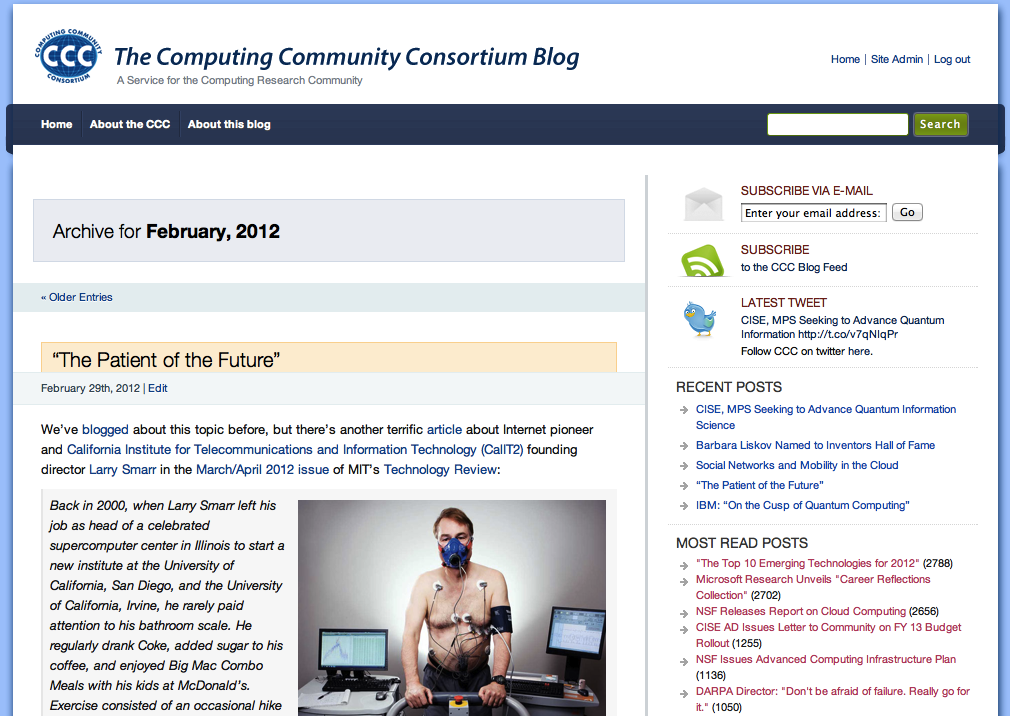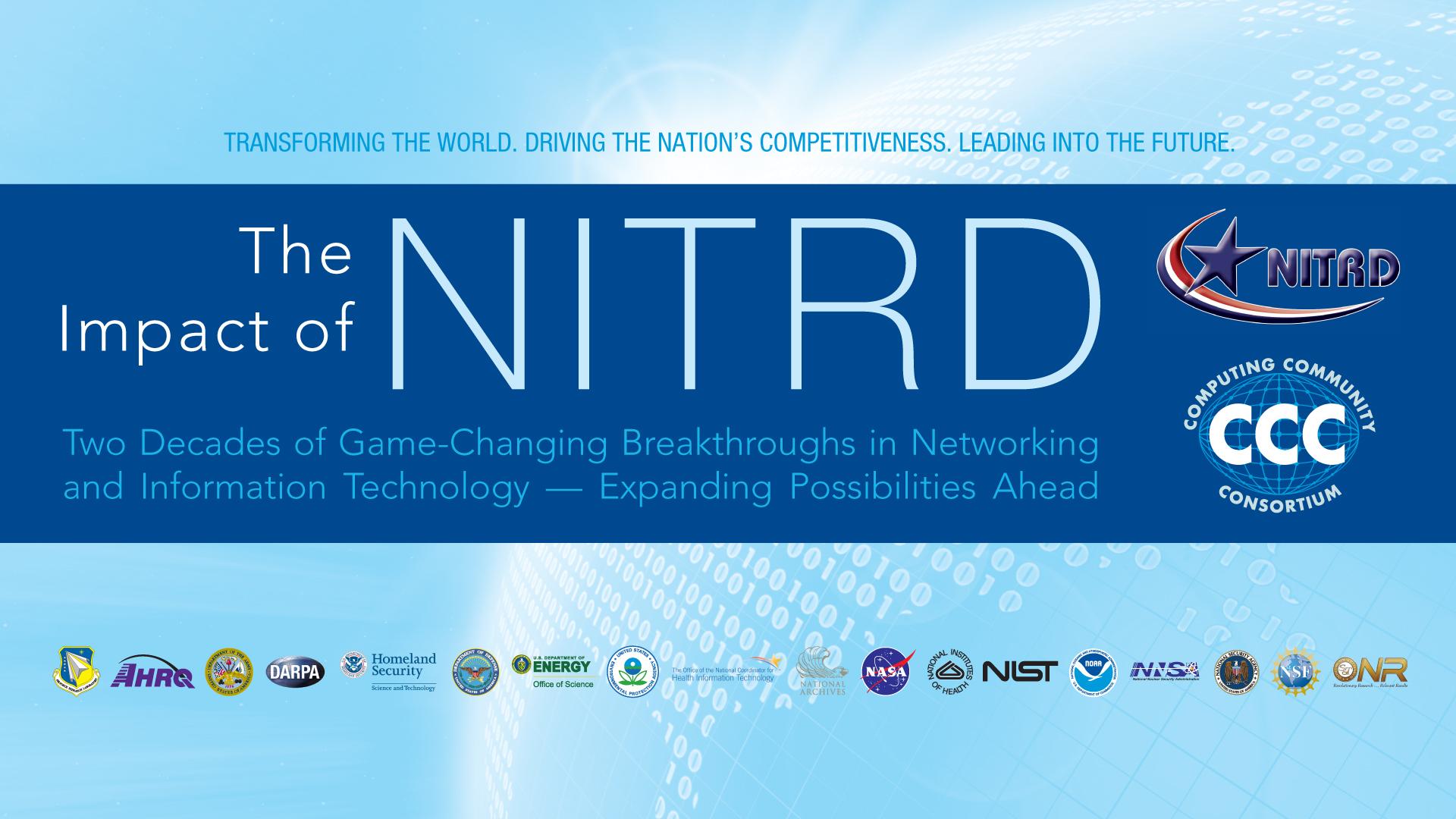 I’d like to pause briefly today to acknowledge you — our readers. On behalf of the CCC Council, many thanks to each of you for reading the CCC Blog regularly, for contributing periodically, and for encouraging your colleagues to do so as well.
I’d like to pause briefly today to acknowledge you — our readers. On behalf of the CCC Council, many thanks to each of you for reading the CCC Blog regularly, for contributing periodically, and for encouraging your colleagues to do so as well.
We saw more traffic to the Blog last month than ever before, and so we thought we would take a quick look back today at the top 10 posts in February (following the link):
10. Microsoft Announces New Policy-Focused Internship Program, Feb. 9
![]() Microsoft’s Technology Policy Group (TPG) announced a new internship program that will offer “a limited number of internships to exceptional candidates interested in helping characterize the long-term policy implications of disruptive technologies.” The program — which entails a separate application and selection process from the long-running Microsoft Research Internship Program — aims to place policy-minded graduate students in computing or related fields in paid internships at Microsoft’s Redmond, WA, campus for 12 weeks this summer.
Microsoft’s Technology Policy Group (TPG) announced a new internship program that will offer “a limited number of internships to exceptional candidates interested in helping characterize the long-term policy implications of disruptive technologies.” The program — which entails a separate application and selection process from the long-running Microsoft Research Internship Program — aims to place policy-minded graduate students in computing or related fields in paid internships at Microsoft’s Redmond, WA, campus for 12 weeks this summer.
—
9. DARPA Director: “Don’t be afraid of failure. Really go for it.”; Feb. 28
![Regina Dugan, DARPA, at a Washington Post Live event in mid-February [image courtesy The Washington Post]. Regina Dugan, DARPA, at a Washington Post Live event in mid-February [image courtesy The Washington Post].](https://cccblog.org/wp-content/uploads/2012/02/IMG_6028_1329304861.jpeg) Defense Advanced Research Projects Agency (DARPA) Director Regina Dugan recently sat on an panel sponsored by Washington Post Live, the live journalism arm of The Washington Post Co. The panel — titled “Innovation and Ideas” — was part of a special series on American Competitiveness: What Works in which corporate executives, political leaders, economists and other experts charted a path for U.S. competitiveness, describing big obstacles — as well as reasons for optimism. As part of a special section summarizing the panels that appeared in the print edition of the Post the following week, Dugan penned a piece describing her view of ideas and innovation — and touched on a recent breakthrough enabled by advances in computing.
Defense Advanced Research Projects Agency (DARPA) Director Regina Dugan recently sat on an panel sponsored by Washington Post Live, the live journalism arm of The Washington Post Co. The panel — titled “Innovation and Ideas” — was part of a special series on American Competitiveness: What Works in which corporate executives, political leaders, economists and other experts charted a path for U.S. competitiveness, describing big obstacles — as well as reasons for optimism. As part of a special section summarizing the panels that appeared in the print edition of the Post the following week, Dugan penned a piece describing her view of ideas and innovation — and touched on a recent breakthrough enabled by advances in computing.
—
8. CISE AD Issues Letter to Community on FY 13 Budget Rollout, Feb. 14
NSF/CISE Assistant Director Farnam Jahanian issued the following letter to the community describing the President’s FY 2013 budget request to Congress:
Dear Computer and Information Science and Engineering (CISE) Community,
Yesterday, the President delivered the Fiscal Year 2013 Budget to Congress. The Administration is requesting a total of nearly $7.4 billion dollars for NSF, which is an increase of $340 million, or almost five percent, over the FY 2012 NSF Enacted level. The Request also includes an increase of $56 million, or 8.6 percent, over the FY 2012 Current Plan for the CISE Directorate, for a total of $709.7 million. For more information on the NSF FY 2013 budget, see: http://www.nsf.gov/about/budget/fy2013/index.jsp…
—
7. NSF Issues Advanced Computing Infrastructure Plan, Feb. 23
![NSF issues a vision and strategic plan for Advanced Computing Infrastructure (ACI) [image courtesy NSF]. NSF issues a vision and strategic plan for Advanced Computing Infrastructure (ACI) [image courtesy NSF].](https://cccblog.org/wp-content/uploads/2012/02/nsfaci.jpg) The National Science Foundation (NSF) released a vision and strategic plan for Advanced Computing Infrastructure (ACI) seeking “to position and support the entire spectrum of NSF-funded communities at the cutting edge of advanced computing technologies, hardware, and software.” The report “also aims to promote a more complementary, comprehensive, and balanced portfolio of advanced computing infrastructure and programs for research and education to support multidisciplinary computational and data-enabled science and engineering that in turn support the entire scientific, engineering, and education community.” ACI is a key component of the Foundation’s Cyberinfrastructure for 21st Century Science and Engineering (CIF21) framework.
The National Science Foundation (NSF) released a vision and strategic plan for Advanced Computing Infrastructure (ACI) seeking “to position and support the entire spectrum of NSF-funded communities at the cutting edge of advanced computing technologies, hardware, and software.” The report “also aims to promote a more complementary, comprehensive, and balanced portfolio of advanced computing infrastructure and programs for research and education to support multidisciplinary computational and data-enabled science and engineering that in turn support the entire scientific, engineering, and education community.” ACI is a key component of the Foundation’s Cyberinfrastructure for 21st Century Science and Engineering (CIF21) framework.
—
6. This Thursday, a Symposium on the Impact of NITRD, Feb. 13
 Since the dawn of the digital age, fundamental research sponsored by the Federal government has supported U.S. leadership in information technology — from the first supercomputers, to the foundations of high-speed networking, to global positioning systems and wireless technologies. Much of the progress in the last 20 years has been enabled by the Federal Networking and Information Technology Research and Development (NITRD) Program, the oldest and largest of a small number of formal Federal programs that engage multiple agencies. On Thursday, Feb. 16, the Computing Community Consortium (CCC), working with the National Coordination Office (NCO) for NITRD, marked two decades of the NITRD Program at a daylong Symposium held at the Newseum in Washington, DC. The Symposium — titled “The Impact of NITRD: Two Decades of Game-Changing Breakthroughs in Networking and Information Technology — Expanding Possibilities Ahead” — explored how we are “transforming the world, driving the nation’s competitiveness, and leading into the future.” The meeting was streamed live via the web.
Since the dawn of the digital age, fundamental research sponsored by the Federal government has supported U.S. leadership in information technology — from the first supercomputers, to the foundations of high-speed networking, to global positioning systems and wireless technologies. Much of the progress in the last 20 years has been enabled by the Federal Networking and Information Technology Research and Development (NITRD) Program, the oldest and largest of a small number of formal Federal programs that engage multiple agencies. On Thursday, Feb. 16, the Computing Community Consortium (CCC), working with the National Coordination Office (NCO) for NITRD, marked two decades of the NITRD Program at a daylong Symposium held at the Newseum in Washington, DC. The Symposium — titled “The Impact of NITRD: Two Decades of Game-Changing Breakthroughs in Networking and Information Technology — Expanding Possibilities Ahead” — explored how we are “transforming the world, driving the nation’s competitiveness, and leading into the future.” The meeting was streamed live via the web.
—
5. “Scientific Visions That Take the Prize,” Feb. 2
![International Science & Engineering Visualization Challenge [image courtesy NSF]. International Science & Engineering Visualization Challenge [image courtesy NSF].](https://cccblog.org/wp-content/uploads/2012/02/header.jpeg) Back in October, we told you about the ninth International Science & Engineering Visualization Challenge — a joint effort by the National Science Foundation (NSF) and Science magazine to celebrate the grand tradition of visualization, specifically for communicating science, engineering, and technology for education and journalistic purposes. For the first time ever, this year’s Challenge allowed participants to submit entries online, and the public was allowed to vote for its favorite images as “People’s Choice” winners. This month, NSF and Science announced the competition’s winners.
Back in October, we told you about the ninth International Science & Engineering Visualization Challenge — a joint effort by the National Science Foundation (NSF) and Science magazine to celebrate the grand tradition of visualization, specifically for communicating science, engineering, and technology for education and journalistic purposes. For the first time ever, this year’s Challenge allowed participants to submit entries online, and the public was allowed to vote for its favorite images as “People’s Choice” winners. This month, NSF and Science announced the competition’s winners.
—
4. The President’s FY 2013 Budget, Feb. 13
![Copies of of President Obama's fiscal 2013 federal budget are displayed at the Government Printing Office in Washington, Feb. 9 [image courtesy Manuel Balce Ceneta/AP via The Washington Post]. Copies of of President Obama's fiscal 2013 federal budget are displayed at the Government Printing Office in Washington, Feb. 9 [image courtesy Manuel Balce Ceneta/AP via The Washington Post].](https://cccblog.org/wp-content/uploads/2012/02/Obama_Budget_018d7.jpeg) The President’s FY 2013 budget request to Congress was released. More details on the Policy Blog, including this handy summary of the Administration’s R&D portions. At NSF, the request called for an 8.6% increase in funding to the Directorate for Computer and Information Science and Engineering (CISE) (an additional $56 million) over FY 2012 levels, bringing the total funding for the directorate to $709.7 million. The request captured CISE’s strong commitment to its core mission of advancing the frontiers of computing (funding to each of its three divisions is up approximately 9 percent) while also identifying several programs elevated to a Foundation-wide level — in these cases, CISE plays a significant role, together with investments from multiple directorates and offices.
The President’s FY 2013 budget request to Congress was released. More details on the Policy Blog, including this handy summary of the Administration’s R&D portions. At NSF, the request called for an 8.6% increase in funding to the Directorate for Computer and Information Science and Engineering (CISE) (an additional $56 million) over FY 2012 levels, bringing the total funding for the directorate to $709.7 million. The request captured CISE’s strong commitment to its core mission of advancing the frontiers of computing (funding to each of its three divisions is up approximately 9 percent) while also identifying several programs elevated to a Foundation-wide level — in these cases, CISE plays a significant role, together with investments from multiple directorates and offices.
—
3. Microsoft Research Unveils “Career Reflections Collection,” Feb. 5
On the occasion of the 20th anniversary of Microsoft Research last September, Microsoft Research organized a day of reflection at the Redmond lab where it asked participants to look back and then forward to the next 20 years of computer science, with the goal of providing advice to young scientists. In a special contribution to the Blog from Eric Horvitz, Distinguished Scientist at Microsoft Research and member of the CCC Council, and Peter Lee, Managing Director of Microsoft Research Redmond, Microsoft made available an overview of highlights from the day of reflection, and also videos from one-on-one interviews.
—
2. “The Top 10 Emerging Technologies for 2012,” Feb. 20
!["The Top 10 Emerging Technologies for 2012" [image courtesy the World Economic Forum's Global Agenda Council on Emerging Technologies]. "The Top 10 Emerging Technologies for 2012" [image courtesy the World Economic Forum's Global Agenda Council on Emerging Technologies].](https://cccblog.org/wp-content/uploads/2012/02/rtxtomw-comp.jpeg) The World Economic Forum’s Global Agenda Council on Emerging Technologies released a consensus list — the result of input from “some of the world’s leading minds within the entire [Global Agenda Council] network” — of “the top 10 emerging technologies for 2012.” These are the technologies that have the greatest potential to create new industries and impact new ones by providing solutions to global challenges. Atop the list — which is ordered starting with the technology with the greatest potential — is “informatics for adding value to information.”
The World Economic Forum’s Global Agenda Council on Emerging Technologies released a consensus list — the result of input from “some of the world’s leading minds within the entire [Global Agenda Council] network” — of “the top 10 emerging technologies for 2012.” These are the technologies that have the greatest potential to create new industries and impact new ones by providing solutions to global challenges. Atop the list — which is ordered starting with the technology with the greatest potential — is “informatics for adding value to information.”
—
1. NSF Releases Report on Cloud Computing, Feb. 7
![NSF Report on Support for Cloud Computing [image courtesy NSF]. NSF Report on Support for Cloud Computing [image courtesy NSF].](https://cccblog.org/wp-content/uploads/2012/02/nsfcloudcomputing.jpg) The National Science Foundation (NSF) released a report on its support for cloud computing, describing the outcomes of “investments in cloud computing research, recommendations for research focus and program improvements, and other related recommendations.” Emphasizing the role of cloud computing — “a vital area of national importance that requires further research and development” — the report highlights some of the 125 cloud computing research awards issued by NSF’s Computer and Information Science and Engineering (CISE) directorate between 2009 and 2011, spanning areas of architecture, algorithms, big data, security and privacy, green computing, and so on.
The National Science Foundation (NSF) released a report on its support for cloud computing, describing the outcomes of “investments in cloud computing research, recommendations for research focus and program improvements, and other related recommendations.” Emphasizing the role of cloud computing — “a vital area of national importance that requires further research and development” — the report highlights some of the 125 cloud computing research awards issued by NSF’s Computer and Information Science and Engineering (CISE) directorate between 2009 and 2011, spanning areas of architecture, algorithms, big data, security and privacy, green computing, and so on.
—
And as I’ve noted previously in this space:
We particularly welcome your involvement. We’re always looking for ways to improve the Blog — which is truly intended to be a service for and about the computing research community. If you have ideas, please let us know by commenting in the space below or sending me e-mail. And please continue to spread the word to your colleagues.
Thanks again, everyone!
(Contributed by Erwin Gianchandani, CCC Director)











